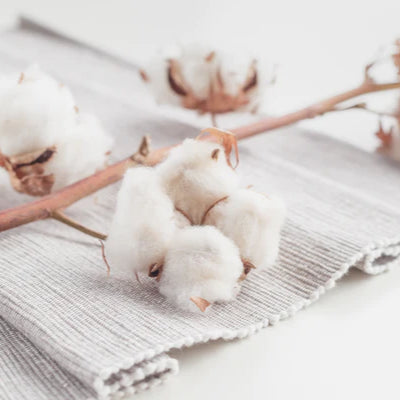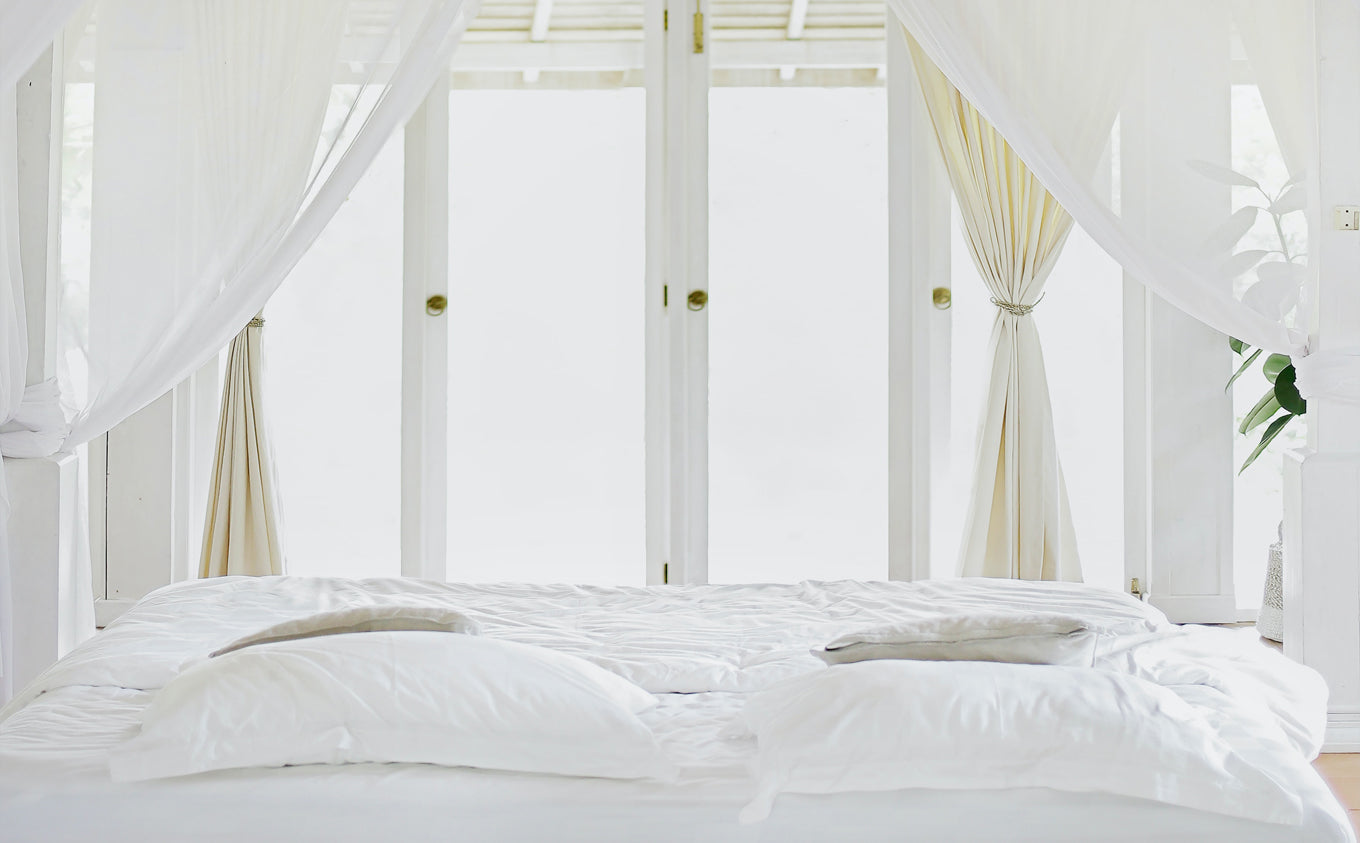Our bedrooms are like sanctuaries- a safe space where we can relax, rest, and unwind. We use them to get away from the stresses of everyday life, and we often decorate them accordingly, with soothing colors and accessories. Unfortunately, a lot of the things we put into our rooms are full of chemicals and can be detrimental to our sleep, our health, and our well being.
We want to help you ensure that your room doesn’t just feel like a safe space but that it actually is one. That’s why we put together this guide on how to create a non-toxic bedroom.
Of course, it’s important to cut down on the toxins throughout our home, but the bedroom is arguably the most important. We spend approximately a third of our lives sleeping, so the items in our room have a big impact on our health. Also, when we sleep, our bodies go into a parasympathetic, or rest-and-repair, state. This is when our bodies heal, digest, repair cells, and more, and we can’t do this properly if we’re being overloaded by toxins and chemicals.
To facilitate our natural healing processes and reduce our chemical burden, we need to replace the chemical filled items in our rooms with natural, non-toxic alternatives.
The following items contain the biggest chemical load and are the first things we recommend switching.
Mattresses
The first place to start is with your mattress. This is where you spend the majority of time in your room, and unfortunately most mattresses are full of harmful chemicals. These chemicals, which can include petrochemicals, synthetic latex made from styrene (a human carcinogen), and plastics and vinyls, release VOCs (volatile organic compounds), which are linked to a number of health concerns including respiratory issues and cancer. Off gassing, which is the release of chemicals from the mattress, can last years. In the case of foam mattresses, even more chemicals can be released as the foam breaks down over time.
Non-toxic alternative: When searching for a non-toxic mattress, the following materials are good to look for: organic wool, 100% natural latex, organic cotton. Also make sure to check for the proper certifications. GOLS (for latex) is the best certification to look for. GOLS means that 95% of the material is 100% organic latex and the other 5% has restrictions and qualifications.
Another good certification is the Oeko-Tex Standard 100. It isn’t as stringent at the GOLS and it doesn’t ensure that any of the material is organic, but it does set limits for VOC emissions and prohibits dangerous flame retardants and dyes.
If replacing your mattress isn’t currently an option (we get it- it’s a pricey investment!), consider getting an organic mattress cover to put a buffer between you and your mattress.
Pillows and bedding
Second to your mattress is the bedding and pillows you’re sleeping on. As with your mattress, most bedding and pillows are full of dyes and chemicals, which you are breathing in all night as you sleep. About 25% of the pesticides used in the US are used to grow cotton! And on top of that, you cotton sheets are often treated with a cocktail of chemicals when they’re being processed.
Non-toxic alternative: Our 100% organic cotton sheets are free from phthalates, formaldehyde, pesticides, and toxic chemicals. They’re also incredibly soft and come in sateen (best for year-round use) and percale (best for summer and warmer climates). Our pillows and comforters are made from responsibly sourced down and covered in a 100% organic cotton shell. Together, our bedding products will ensure that you’re enjoying the best sleep possible, with no harmful chemicals or toxins.
Scented products and candles
Candles, plug-ins and room sprays are common bedroom items, and most are full of chemicals that can mess with the air quality in your room. Remember, you spend all night breathing whatever is in the air! Laundry detergent and cleaning products also leave behind residue on our sheets, pajamas, and surfaces.
Non-toxic alternatives: Find natural alternatives for as many products in your room as possible. There are many great cleaning and laundry products on the market, and you can also get natural room sprays or make your own using essential oils. When it comes to candles, skip paraffin and choose 100% soy, beeswax, coconut wax, or another natural combination that doesn’t contain paraffin. Our line of candles are made from 100% soy and are scented with essential oils.
Electronics
Though not as tangible, or studied, as the other harmful toxins on this list, artificial electromagnetic fields, or EMFs, have been raising concern in the health and wellness communities. Artificial EMFs are emitted from electronics, like your computer and smartphones, and are believed to have some pretty serious health implications, though more research needs to be done before we can have a clear picture of their effects.
Non-toxic alternative: The best thing to do is to leave your electronics as far from your bed as possible when you sleep. Many of us use our smartphones as alarm clocks, but it’s ideal to go with a separate alarm clock. If you do want to use your phone, switch it to airplane mode while you sleep to cut down on the level of artificial EMFs.
These are the main items in your room that we recommend swapping for natural alternatives, but there are also a number of things you can add or do to your room to create a healthy, non-toxic oasis. This doesn’t have to be pricey either! Choose the options that are right for you and don’t stress about doing it all.
Open your windows
They say the best things in life are free, and this applies to this tip! Opening your windows costs you nothing (provided you don’t have your heat and AC going), and it can make a huge difference on the air quality in your room. Pollutants are actually higher in indoor air than outdoor air because of all the products and furnishings we have in our home. By opening your windows periodically (or ideally, daily), you’ll air out your space and bring in fresher, cleaner air.
It’s also a great idea to have your windows open while you sleep, if possible. It’s hard to get a good sleep in a stuffy room, so allowing fresh air to flow in will help you get a great rest.
Bring in plants
Plants are another effective and natural way to purify the air in your room. Make sure you choose the right plants though because not all are great for air quality. Boston Ferns are among the best for bedrooms because they are a great formaldehyde purifying plant. Other good options include English Ivy, Mother-in-Law’s Tongue, Aloe Vera, Gerber Daisies, and Spider plants.
Air purifiers
If you want to take things a step further, you can invest in an air purifier to ensure that you’re getting the best air quality possible. Depending on your budget, you may go for a high-end machine, but you can also choose budget friendly charcoal air purifiers. These all natural, non-toxic bags remove allergens, odors, and pollutants from your room and generally cost less than $10.
We hope this list helped you to make the switch to a non-toxic bedroom! Remember, you don’t have to overwhelm yourself and make all these changes at once- simply choose a few that you’d like to begin with (even just opening your windows!) and go from there. To find your organic bedding, shop our selection here.
Luxury Organic Cotton Sheets.
Our favorite tip for freshening up your bedroom is to add our organic, fair trade bedding. Check out our selection below:
SHOP YOUR ORGANIC BEDDING TODAY!
Please use promo code BLOG20 for 20% off & free shipping on your SOL bedding order.








Gail L. Taylor
February 25, 2020
Thank You! Appreciate the reminders and info about making our bedroom a safe, clean and effective sanctuary to unwind, repair and possibly prevent further damage to our bodies and minds.